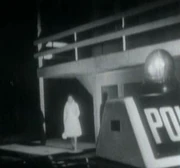
Elsie Tanner outside the maisonettes
The Maisonettes were a row of seven one and two-storey flats that which stood on the south side of Coronation Street, Weatherfield from 1968 to 1971. Built by Weatherfield Council as part of a housing redevelopment scheme, the Maisonettes were an example of 1960s brutalist architecture, a fashionable style of building design at that time. In Coronation Street, they replaced the Glad Tidings Mission Hall and Elliston's Raincoat Factory, which had previously stood on the site.
The block was comprised of four two-storey, three bedroom flats, accessed from ground level, and three OAP ground floor-flats. Despite attracting some interest when they were built, they were largely unpopular with the locals and by 1969 still less than half of them had been lived in, with neighbours blaming the dereliction of the Maisonettes on the fact that they were damp and cheaply built.
In 1971, the Barlows, who lived in No. 14, were emigrating to Jamaica, but on the night they were moving out of the Maisonette Valerie Barlow was electrocuted in her home and started a fire. The fire exposed structural faults in the building and the council therefore condemned the property and demolished it. A Community Centre and the Mark Brittain Warehouse were erected in their place.
Flats
4 Coronation Street
Widow Effie Spicer lived here from 1968 to 1969.
6 Coronation Street
Ground-floor OAP flat inhabited by Ena Sharples from 1968 to 1969. She moved out when she decided she had had enough of the Maisonette.
12 Coronation Street
Dave Robbins expressed an interest in this two-storey flat, next door to the Barlows, in 1969, but his real reason was to move in a squatter family of a mother and three children after her husband had been sent to jail for three years. The occupancy divided the residents of the street along political and moral lines but after a week the family moved out before they could be evicted by Len Fairclough and the council after a farmer in the Cheshire village of Chelford offered the mother, Mrs Storey, a job and accommodation to go with it.
14 Coronation Street
Two-storey flat with ground-floor entrance. The Barlow family - Ken, Valerie and twins Peter and Susan Barlow - lived there from 1968 to 1971. The family had previously lived at 9 Coronation Street directly opposite the Maisonettes.
Background information

The rarely-seen maisonette frontage in the first outdoor set
Since 1960, scenes set on the Street had been recorded inside a cramped studio, which made recording difficult. In 1967, Granada Television took the decision to build an Outdoor Set. At the time, many real world streets like Coronation Street were being demolished and being replaced by tower blocks, which could house many more people in the same space. The modern-looking brutalist maisonettes replaced the outdated Mission hall and factory, reflecting current trends in housing but keeping the actual row of terraced houses that were the centrepoint of the Street and the programme. The building of the outdoor set coincided with the storyline of the construction of the Maisonettes in 1968.
Unfortunately, the Maisonettes weren't the success the producers had initially hoped for. Although the Barlows and Ena Sharples were moved to inhabit the new flats, the casting budget didn't stretch far enough to introduce any new families; Effie Spicer was the only new character brought in to live there, although by mid-1969 Effie had left the programme and Ena had been moved to Ernie Bishop's camera shop flat. Ultimately, the Maisonettes were counterproductive as they left the residents with few places to interact as a community and, although the inside of Elliston's factory had not been seen often, it had provided a workplace for younger characters in the 1960s and was a useful vehicle with which to introduce younger characters.

The maisonettes in 1970 when the Grape Street set was opened to the public over the weekend of 29th to 31st August.
In 1971, when Anne Reid chose to leave the series, the writers used the character's death as an opportunity to demolish the Maisonettes and replace them with the more traditional Mark Brittain Warehouse and Community Centre. It wasn't until 1990 that residential houses would be built on the "other" side of the Street, and on that occasion space was left for assorted business units which would still allow characters to interact in a workplace environment.
